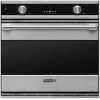Viking RDSOE306SS Use and Care Manual - Page 21
Broiling Tips, Broiling Chart
 |
View all Viking RDSOE306SS manuals
Add to My Manuals
Save this manual to your list of manuals |
Page 21 highlights
Operation Broiling Broiling Chart Type and Cut of Meat Weight Setting BEEF Sirloin, 1" Rare 14 oz Hi Broil Medium 14 oz Hi Broil Well done 14 oz Hi Broil T-Bone, 3/4" Rare 10 oz Hi Broil Medium 10 oz Hi Broil Well done 10 oz Hi Broil Hamburger, 1/2" Rare 1/4 lb. Hi Broil Medium 1/4 lb. Hi Broil Well done 1/4 lb. Hi Broil CHICKEN Bnls breast 1" 1/2 lb. Med-Broil Bnls breast 1" 1/2 lb. Convection Broil Bones in Breast 2 -3 lbs. total Med Broil Bones in Breast 2 -3 lbs. total Convection Broil Chicken pieces 2 -3 lbs. total Med Broil Chicken pieces 2 -3 lbs. total Convection Broil HAM Ham slice, 1" 1 lb. Med Broil LAMB Rib chops, 1" 12 oz. Convection Broil Shoulder 1 lb. Convection Broil PORK Loin chops, 3/4" 1 lb. Convection Broil Bacon Med Broil FISH Salmon steak 1 lb. Med Broil Fillets 1 lb. Med Broil Rack 5 or 6 5 or 6 5 or 6 5 or 6 5 or 6 5 or 6 5 or 6 5 or 6 5 or 6 5 or 6 4 or 5 3 or 4 3 or 4 3 or 4 3 5 or 6 4 or 5 4 or 5 4 5 4 4 or 5 Note: The above information is given as a guide only. Time (min) 8-10 10-12 11-13 7-8 9-10 11-12 6-7 7-8 8-9 15-20 15-20 40-45 25-30 40-45 25-30 22 7 6 14 6 7 6 40 Broiling Broiling Tips • ALWAYS use a broiler pan and grid for broiling. They are designed to provide drainage of excess liquid and fat away from the cooking surface to help prevent splatter, smoke, and fire. • To keep meat from curling, slit fatty edge. • Brush chicken and fish with butter several times as they broil to prevent drying out. To prevent sticking, lightly grease broiler tray. • Broil on first side for slightly more than half the recommended time, season, and turn. Season second side just before removing. • ALWAYS pull rack out to stop position before turning or removing food. • Use tongs or a spatula to turn meats. NEVER pierce meat with a fork, as this allows the juices to escape. • Remove the broiler pan from the oven when you remove the food. Drippings will bake onto the pan if it is left in the heated oven after broiling. While pan is hot, place damp paper towel over grid. Drizzle with liquid dishwashing detergent and pour water over grid. This will make cleaning of the pan easier, or the broiler pan can be lined with aluminum foil to make cleaning easier. Be sure the foil extends up the side of the pan. Although it is not recommended, the grid can also be covered with foil. Be sure to slit openings to conform with the openings in the grid so melted fat can drain through to prevent spattering, smoking, or the possibility of grease fire. 41 Operation















